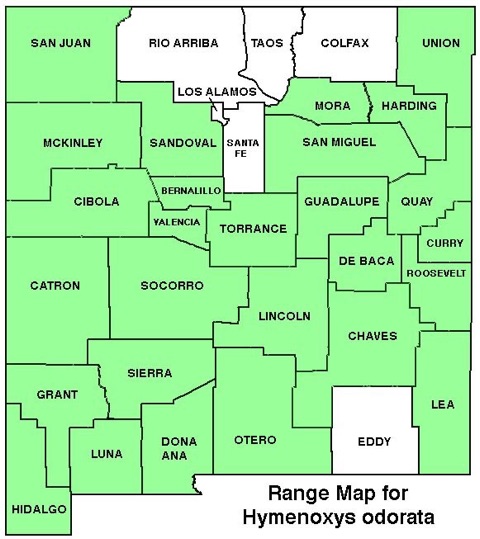WILDFLOWERS OF NEW MEXICO

With up to 25 densely branching stems, this 2-foot tall and wide, robust plant thrives in abused rangeland and waste places. The rounded mounds with dark-green, thread-like leaves, and numerous yellow flower heads with rays tipped with 3 rounded lobes help distinguish this flower.
FLOWER: April–August. One plant can have 15 to more than 100 showy, yellow flower heads on erect, leafless stems (peduncles) 3/4–4 3/4 inches long (2–12 cm); each head has 8–13 petal-like ray flowers 3/8–1/2-inch long, widely spaced, and tipped with 3 lobes; disk flowers are yellowish-orange. The base of the flower head (calyx) has two unequal rows of point-tipped bracts or phyllaries; the lower third of the bases of the outer phyllaries are united.
LEAVES: Basal leaves wilt by flowering. Alternate stem leaves, 3/4–4-inches long, gland-dotted, have 3-15 thread-like segments along the midrib.
HABITAT: Sandy, silty, gravelly soils in low, drainage areas, disturbed areas, washes; shortgrass prairies, desert grasslands, desert scrub.
ELEVATION: 3,800–6,500 feet.
RANGE: AZ, CA, CO, KA, NM, OK, TX.
SIMILAR SPECIES: The erect plant, Pingue Rubberweed, H. richardsonii, grows at higher elevations in pinyon-juniper, ponderosa, and spruce-fir woodlands. Four-nerve Bitterweed, Tetraneuris scaposa, has a dense basal cluster of linear leaves and leafless flower stems to 16-inches tall.
NOTES: Cattle avoid the aromatic, bitter tasting, toxic plant, but sheep can develop a taste for it and are often poisoned.
NM COUNTIES: Nearly statewide, except northern NM high country, in low-elevation, dry habitats: Bernalillo, Catron, Chaves, Cibola, Curry, De Baca, Dona Ana, Grant, Guadalupe, Harding, Hidalgo, Lea, Lincoln, Luna, McKinley, Mora, Otero, Quay, Roosevelt, San Juan, San Miguel, Sandoval, Sierra, Socorro, Torrance, Union, Valencia.

BITTERWEED
HYMENOXYS ODORATA
Aster Family, Asteraceae
Annual herb



THE CONTENTS OF THIS WEBSITE ARE COPYRIGHTED AND CANNOT BE USED
WITHOUT PERMISSION OF GEORGE OXFORD MILLER


Poisonous, bitter tasting, and unpalatable to livestock, Bitterweed is the signature of overgrazing.
Bitterweed typically grows as a rounded plant with dark-green foliage.

Bitterweed leaves are divided into numerous, filament-like segments.

EMAIL ME